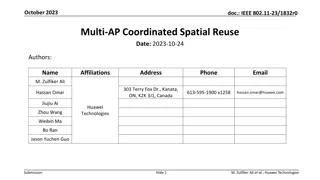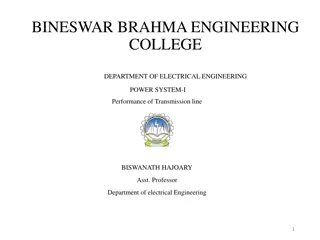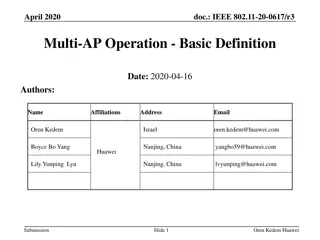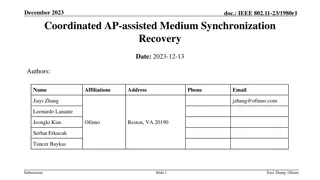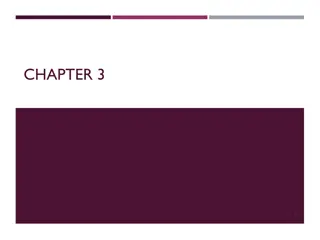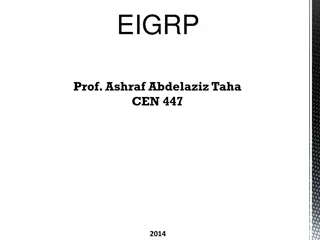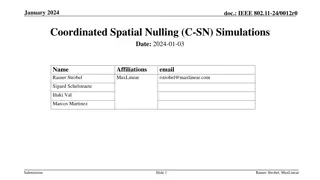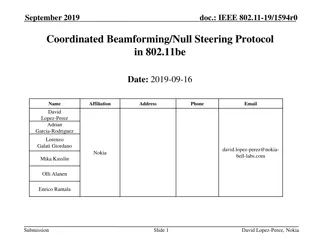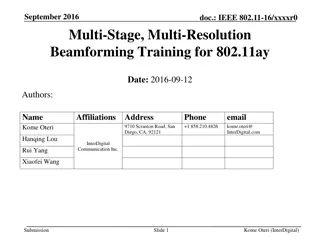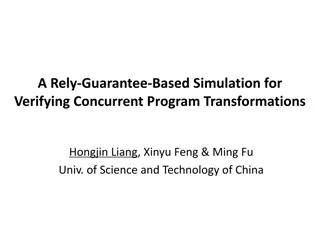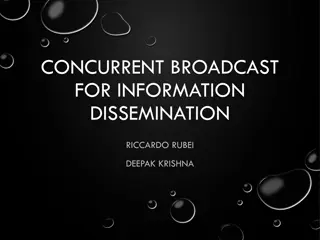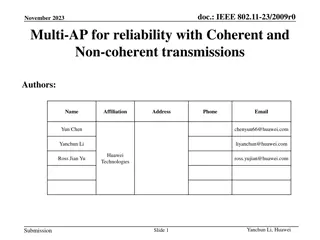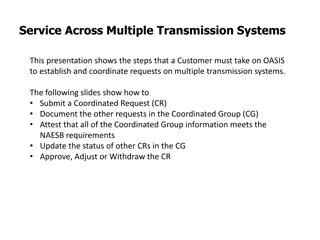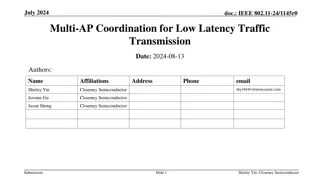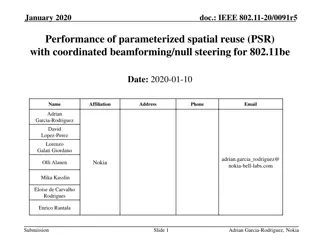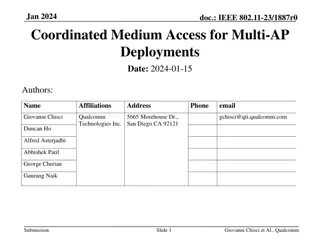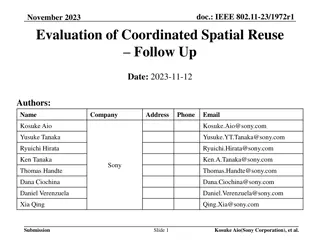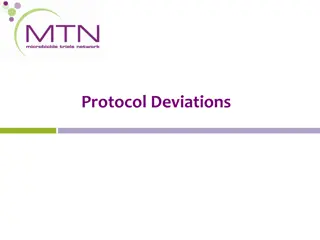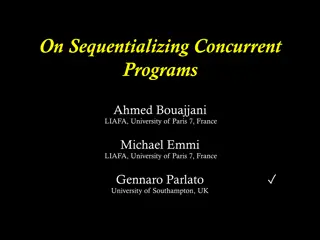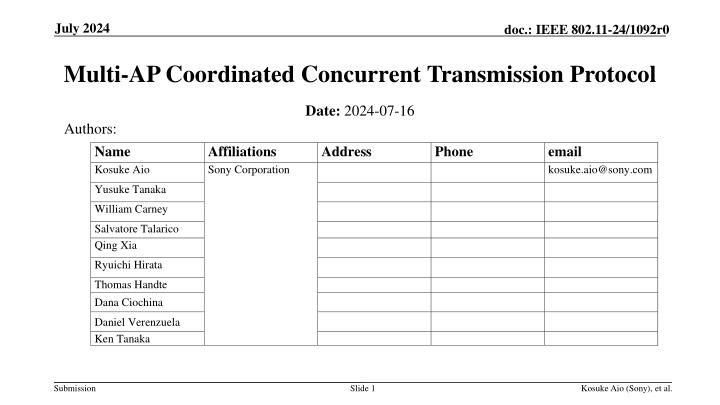
IEEE 802.11-24 Multi-AP Coordinated Concurrent Transmission Protocol
In the IEEE 802.11-24 document, the Multi-AP Coordinated Concurrent Transmission Protocol is discussed to enhance throughput in multi-BSS environments. The protocol aims to support Coordinated SR and Coordinated BF methods for concurrent transmission, improving network performance. Various interference mitigation techniques are proposed to optimize data transmission between multiple Access Points and STAs. This contribution addresses the definition, requirements, and motivations behind Coordinated Concurrent Transmission in the context of TGbn objectives.
Download Presentation

Please find below an Image/Link to download the presentation.
The content on the website is provided AS IS for your information and personal use only. It may not be sold, licensed, or shared on other websites without obtaining consent from the author. If you encounter any issues during the download, it is possible that the publisher has removed the file from their server.
You are allowed to download the files provided on this website for personal or commercial use, subject to the condition that they are used lawfully. All files are the property of their respective owners.
The content on the website is provided AS IS for your information and personal use only. It may not be sold, licensed, or shared on other websites without obtaining consent from the author.
E N D
Presentation Transcript
July 2024 doc.: IEEE 802.11-24/1092r0 Multi-AP Coordinated Concurrent Transmission Protocol Date: 2024-07-16 Authors: Name Kosuke Aio Affiliations Sony Corporation Address Phone email kosuke.aio@sony.com Yusuke Tanaka William Carney Salvatore Talarico Qing Xia Ryuichi Hirata Thomas Handte Dana Ciochina Daniel Verenzuela Ken Tanaka Submission Slide 1 Kosuke Aio (Sony), et al.
July 2024 doc.: IEEE 802.11-24/1092r0 Introduction Multi-AP coordination is a candidate feature for TGbn as a technology to realize the several objectives and use cases of UHR [1]. Among many coordination types, Coordinated SR [2-8] and Coordinated BF [8-12] are both expected to directly improve throughput in multiple BSSs environment by allowing concurrent transmission by the same channel. In this contribution, we discuss the baseline and proposed extensions to the design of Multi- AP Coordinated Concurrent Transmission (Co-CT) protocol to support both Coordinated SR and Coordinated BF. Submission Slide 2 Kosuke Aio (Sony), et al.
July 2024 doc.: IEEE 802.11-24/1092r0 Motivation for Coordinated Concurrent Transmission TGbn PAR is defined as one of the scope to improve throughput in multi-BSSs environment as follows [1] This amendment defines modifications to both the IEEE Std 802.11 physical layers (PHY) and the IEEE Std 802.11 Medium Access Control (MAC). The amendment adds an Ultra High Reliability capability to a Wireless Local Area Network (WLAN). The Ultra High Reliability capability is defined, for both an isolated Basic Service Set (BSS) and overlapping BSSs as: at least one mode of operation capable of increasing throughput by 25%, as measured at the MAC data service Access Point, in at least one Signal to Interference and Noise Ratio (SINR) level (Rate-vs-Range), compared to the Extremely High Throughput MAC/PHY operation, and Concurrent Transmission is the most effective way to achieve the above scope. Various promising features have been discussed so far, but Multi-AP contributes the most to performance improvement in multi-BSSs environment. Furthermore, concurrent transmission using the same channel can directly improve throughput. To achieve the TGbn s scope, this contribution discusses the realization of Coordinated Concurrent Transmission (Co-CT) as Multi-AP coordination protocol. Submission Slide 3 Kosuke Aio (Sony), et al.
July 2024 doc.: IEEE 802.11-24/1092r0 Definition and Requirement for Co-CT Proposed definition of Multi-AP Coordinated Concurrent Transmission: At least two APs can transmit at least two PPDUs concurrently using the same channel, with advanced knowledge of interference to at least one non-AP STA and (if necessary) mitigation of the interference. At least one AP must know the amount of interference to a STA transmitted by the other AP. If the amount of interference will not be a problem, data transmission is performed as before. If the amount of interference will be a problem, data transmission is performed with interference mitigation. Interference mitigation can be realized by Transmission Power Control (= Coordinated SR). Interference mitigation can be realized by Beamforming (= Coordinated BF). Interference mitigation can also be realized by the combination of Transmission Power Control and Beamforming. Interference mitigation methods and candidate values could be pre-negotiated/calculated/defined. Whether or not to use those interference mitigation methods and which candidate parameters to use may be determined immediately before data transmission. Submission Slide 4 Kosuke Aio (Sony), et al.
July 2024 doc.: IEEE 802.11-24/1092r0 Similarities/Differences between Coordinated SR/BF There are lot of similarities between Coordinated SR and Coordinated BF, for instance.. Interference link (AP - OBSS STA) must be pre-measured. To mitigate interference, at least Shared AP*1 must know which STA Sharing AP *1 will transmit data to. Of course, Sharing AP may ask for information on which STA Shared AP will transmit data to for interference mitigation. Sharing APs need some degree of synchronization with Shared AP(s) On the other hands, there are some differences between them, for instance Type of information needed for interference measurement: RSSI is OK for power control only, CSI information is needed for Beamforming. Required Synchronization Accuracy: Coordinated BF requires more precise synchronization. *1: In this contribution, as with TGbe sdefinition, an AP that allows Coordinated Simultaneous Transmission are called Sharing AP , and an AP that are allowed Coordinated Simultaneous Transmission are called Shared AP . Submission Slide 5 Kosuke Aio (Sony), et al.
July 2024 doc.: IEEE 802.11-24/1092r0 Base Protocol Design for Co-CT Considering the similarities/differences, we propose the following protocol for Multi-AP Coordinated Concurrent Transmission as baseline. 1. Co-CT Measurement Phase: Interference link measurement between APs and STAs 2. Co-CT Configuration Phase: Negotiations to define the availability, interference mitigation methods and candidate transmission parameters for Coordinated Concurrent Transmission. 3. Co-CT Transmission(Tx) Phase: Coordinated Concurrent Transmission among Sharing AP and Shared AP(s) Assuming 1 and 2 are long-term(every 100-200ms) and 3 is short-term (every TXOP). Submission Slide 6 Kosuke Aio (Sony), et al.
July 2024 doc.: IEEE 802.11-24/1092r0 Co-CT Measurement Phase Pre-measurement of the channel state of the interference link for Co-CT configuration. Typically, Sequential Sounding discussed in TGbe can be utilized [13]. Multiple APs can sequentially use an 802.11ax-like sounding sequence (NDPA + NDP + BFRP TF + Feedback (e.g., CSI report)) to collect CSI from the in-BSS STAs and OBSS STAs. Multiple APs can send NDP and collect feedback either in the same TXOP or in separate TXOPs; in the former case, Coordinated TDMA is effective. The feedback should be extended to inform only SNR (RSSI) information (always not CSI), considering the case where only power control is performed to reduce the measurement overhead. Example Procedure AP1 obtains TXOP Each AP can collect feedback from OBSS STAs AP1 uses C-TDMA scheme to complete the measurement in a TXOP STA1x/2x is a STA associating with AP1/2 respectively. Submission Slide 7 Kosuke Aio (Sony), et al.
July 2024 doc.: IEEE 802.11-24/1092r0 Co-CT Configuration Phase Based on the acquired information of the interference link, multiple APs negotiate to define the availability, interference mitigation methods and candidate transmission parameters for Coordinated Concurrent Transmission. For instance.. 1. An AP sends Coordination Set Request frame including the allowable interference power value for every STA to other APs. 2. The AP receiving Coordination Set Request frame configures Coordinated Concurrent Transmission for every STA, then sends Coordination Set Response frame including the following information. a. Availability Whether or not Coordinated Concurrent Transmission is performed b. Interference mitigation method Whether or not beam forming is used for interference mitigation Whether or not transmission power control is used for interference mitigation c. Candidate transmission parameters Transmission power, BW, MCS, and so on The configuration method is implementation-dependent, but a simple example is given in the Appendix. Submission Slide 8 Kosuke Aio (Sony), et al.
July 2024 doc.: IEEE 802.11-24/1092r0 Co-CT Tx Phase The AP that obtains TXOP gets a role of Sharing AP and performs Concurrent Transmission. 1. Sharing AP initiates TXOP with ICF (Initial Control Frame) to other APs and STAs and receives ICR from them. ICF/ICR is used to set NAV and to confirm/define Co-CT configuration (whether Shared AP(s) can participate in Co-CT or not, which STAs should be interference mitigated, etc.) 2. Sharing AP may send Coordination Trigger frame to Shared AP(s). Trigger frame will be useful for synchronization among multiple APs. 3. Sharing AP/Shared APs start Coordinated Concurrent Transmission. 4. Each AP collects Block Ack(BA) from STA. Detail in Ack procedure is discussed in Slide.13 Submission Slide 9 Kosuke Aio (Sony), et al.
July 2024 doc.: IEEE 802.11-24/1092r0 Discussion.1: Timing of each Phase The timing of the three phases can be done in various ways. Need to consider the best case. Example.1: Measurement/Configuration for each AP are executed in the same TXOP Example.2: Measurement/Configuration for all APs are executed in the same TXOP AP1/AP2 may have to use C-TDMA scheme in Measurement/Configuration Phase Example.1 Exapmle.2 Submission Slide 10 Kosuke Aio (Sony), et al.
July 2024 doc.: IEEE 802.11-24/1092r0 Discussion.2: Robustness Pre-determining the parameter values of Concurrent Transmission eliminates the need for complex calculations per TXOP. On the other hand, if the time between Measurement Phase and Concurrent Transmission is long, the interference mitigation effect may be lost due to mismatches between measurement results and channel conditions (especially for Beamforming). Concurrent Transmission must be designed with robustness in mind. For example, in the situation shown in Appendix 2, a minimum of 15 dB of interference mitigation can be achieved in 11ac Channel Model D and every 100ms measurement on a stable basis. This value should be considered as a target. Mechanisms to enhance robustness may also be considered (e.g., shortening the Sounding Interval, etc.). Submission Slide 11 Kosuke Aio (Sony), et al.
July 2024 doc.: IEEE 802.11-24/1092r0 Discussion.3: Channel Setting APs that perform Concurrent Transmission do not necessarily need to be configured on the same Primary Channel [14] There are many advantages to set different Primary Channels between multiple APs It is very easy to design some operation (such as Ack Procedure) as described from next page. Transmission of low latency traffic that does not require wideband or control frame transmission does not compete for TXOP. The Sharing AP will only attempt Concurrent Transmission if it needs wide bandwidth data transmission and overlaps with the other AP's Primary Channel. Submission Slide 12 Kosuke Aio (Sony), et al.
July 2024 doc.: IEEE 802.11-24/1092r0 Discussion.4: Ack Procedure When Sharing AP and Shared AP are on different Primary Channels, each AP can receive Ack on its own Primary Channel. When Sharing AP and Shared AP are on the same Primary Channel, each AP can receive Ack by any of the following methods. Opt.1: Use UL OFDMA in 20MHz units Opt.2: Shared AP receives Ack by Delayed Ack (BAR). Different PCH case Same PCH case (Opt.1) Submission Slide 13 Kosuke Aio (Sony), et al.
July 2024 doc.: IEEE 802.11-24/1092r0 Summary We proposed the Multi-AP Coordinated Concurrent Transmission (Co-CT) baseline protocols such as Coordinated SR/Coordinated BF. Co-CT Measurement Phase: Interference link measurement between APs and STAs Co-CT Configuration Phase: Negotiations to define the availability, interference mitigation methods and candidate transmission parameters for Coordinated Concurrent Transmission. Co-CT Tx Phase: Coordinated Simultaneous Transmission among Sharing AP and Shared AP(s) We discussed some items for Multi-AP Coordinated Concurrent Transmission (Co-CT) protocols as extension. Timing of each Phase Robustness Channel Setting Ack procedure Submission Slide 14 Kosuke Aio (Sony), et al.
July 2024 doc.: IEEE 802.11-24/1092r0 References [1] Laurent Cariou (Intel), UHR proposed PAR, 23/0480r3 [2] Jason Yuchen Guo (Huawei), Coordinated-Spatial-Reuse-Design, 23/1868r2 [3] Jinyoung Chun (LG Electronics), Coordinated Spatial Reuse, 24/1917r0 [4] Kosuke Aio (Sony Corporation), Evaluation of Coordinated Spatial Reuse - Follow Up, 23/1972r1 [5] Yusuke Tanaka (Sony), Coordinated Spatial Reuse discussion, 24/0529r1 [6] Sherief Helwa (Qualcomm), Thoughts on Coordinated Spatial Reuse (C-SR), 24/0577r0 [7] Jun Minotani (Panasonic, Consideration on C-SR Types, 24/0640r0 [8] MaxLinear, Coordinated Spatial Re-Use and Coordinated Spatial Nulling Follow-Up, 24/0635r0 [9] Okan Mutgan (Nokia), Coordinated Beamforming for 802.11bn, 24/0010r0 [10] Dana Ciochina (Sony), Residual Interference in CBF, 24/0142r1 [11] Kiseon Ryu (NXP), TXOP Sharing for C-BF transmission, 24/0387r0 [12] Sindhu Verma (Broadcom), MAC protocol aspects of multi-AP coordination, 24/0639r0 [13] Feng Jiang (Intel), Channel sounding for Multi-AP CBF, 20/0123r0 [14] Kosuke Aio (Sony Corporation), Backhaul Design and Channel Setting for Multi-AP, 24/0838r0 Submission Slide 15 Kosuke Aio (Sony), et al.
July 2024 doc.: IEEE 802.11-24/1092r0 SP #1 Do you support to add the following feature to to TGbn SFD? At least two APs can transmit at least two PPDUs concurrently using the same channel, with advanced knowledge of interference to at least one non-AP STA and (if necessary) mitigation of the interference. The interference mitigation includes transmission power control, Beamforming, and so on Submission Slide 16 Kosuke Aio (Sony), et al.
July 2024 doc.: IEEE 802.11-24/1092r0 Appendix.1: Example of MAP-CT Configuration Phase When an AP receives Coordination Set Req. including allowable interference info for an OBSS STA 1. Calculate required interference mitigation value for the AP from the allowable interference info and pathloss between the AP and the OBSS STA. 2. Calculate allowable transmit power from the required interference mitigation value. 3. Calculate estimated SINR at a STA which the AP wants to send data with the allowable transmit power. 4. If the estimated SINR is above a target SINR value, the AP responses Coordination , No BF control and the allowable Tx power (End). 5. If the estimated SINR is below the target SINR value, the AP check if it can control beamforming and can mitigate interference much than the required interference mitigation value. 6. If the AP can control beamforming and mitigate much interference, the AP responses Coordination , BF control and the allowable Tx power (End). 7. Otherwise, the AP responses Non-Coordination (End). Submission Slide 17 Kosuke Aio (Sony), et al.
July 2024 doc.: IEEE 802.11-24/1092r0 Appendix.2: Simulation about Robustness of CBF ? ?? STA2 (Steered null) ?? AP STA1 (4x1 vector) (Intended Receiver) Periodical sounding is assumed (Sounding interval: 104 [msec]) - Overhead isn t considered ? is calculated to maximize SLNR [1] - Beam steers to STA1 while null steers to STA2 |?1?|,|?2?| are plotted in the right figure. Each ?doesn t include pathloss Configuration - Channel Model: D-NLOS - AP: 4 ant. STA1/2: 1 ant. - Carrier Frequency: 5GHz - Doppler Freq: 0.41Hz - Bandwidth: 20MHz, Subcarrier: 256 Submission Slide 18 Kosuke Aio (Sony), et al.

